#Walter von Reichenau
Explore tagged Tumblr posts
Text

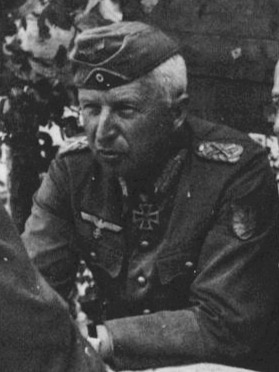

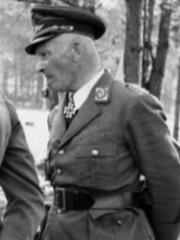
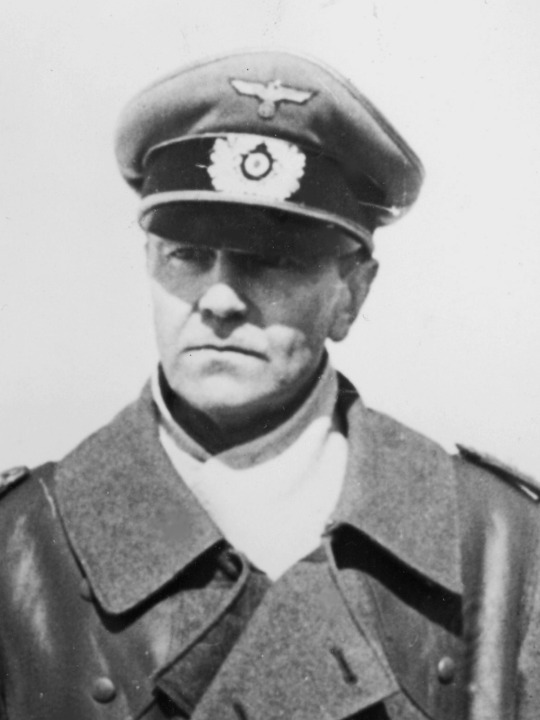
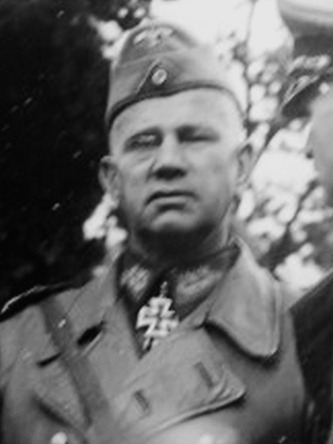


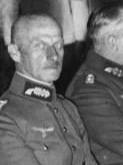

you have been judged by the generalfeldmarschalle :)
#i should stop posting shits honestly#but i wont😛❤️#generalfeldmarschall#heer#wehrmacht#3rd reich#wilhelm list#erich von manstein#fedor von bock#wolfram freiherr von richthofen#friedrich paulus#walter von reichenau#erwin von witzleben#walter model#wilhelm ritter von leeb#georg von küchler
35 notes
·
View notes
Text


Why does he look so annoyed?
all in all, I like this experiment.
22 notes
·
View notes
Link
Walter Karl Ernst August von Reichenau was a German Generalfeldmarschall in the Heer (Army) of Nazi Germany during World War II. He was nicknamed "The Bull." Re...
Link: Walter von Reichenau
0 notes
Note
what’s with all the nazi stuff?
I am fascinated with Wehrmacht and its Prussian military aristocracy, but I am uninterested in Nazism and disapprove it. One marshal who stands out in this respect is Fedor von Bock, who had been very close to Kaiser Wilhelm II his whole life, despite it pissed off Hitler. Ewald von Kleist treated people in the occupied Soviet zones with a lot of humanity. Later on in the war trial, Stalin pinned on him a crime called “alienation of the Soviet people from communist ideology” because he “treated the POWs too well”. Pretty hilarious if you think about it.
Many of the greatest innovative technics, including how to protect soldiers or conduct troops, came from humble background generals like Heinz Guderian and Erwin Rommel, who unfortunately fell victims for political struggles. I have mixed feelings for Doenitz for his technological genius and the cruelty of his strategies, but I believe Admiral Chester Nimitz of the United State navy defended him for solid reasons. Anyway, later on in the war Hitler distanced himself from the traditional military class (too many assassination attempts for this dictator’s taste), and used Walter Model heavily; it also resulted in his life being lost, in a way.
However, I do consider their blind devotion to the country, their out-dated sense of aristocratic aloofness and their inactivity during political turmoil and the SS bullshit as major moral weakness, some went as far as to consider Nazism "a chance to re-invent the crisis-ridden military class". Walter von Reichenau was an example. But this general died under suspicious circumstances. Hitler didn't like him too much, after all.
5 notes
·
View notes
Video
youtube
Death of Walter Von Reichenau - Fanatical Nazi Field Marshal & Hitler's Protegee - World War 2
6 notes
·
View notes
Text

• Hermann Hoth
Hermann Hoth was a German army commander and war criminal during World War II. He fought in the Battle of France and as a panzer commander on the Eastern Front.
Born in Neuruppin, German Empire on April 12th, 1885, Hoth joined the army in 1903 and was awarded both classes of the Iron Cross during World War I. He remained in the Reichswehr (the armed forces of the Weimar Republic) in the interwar period. Following the reorganization of the German military into the Wehrmacht in 1935, he was appointed to command the 18th Infantry Division. Hoth was promoted to Lieutenant-General and given command of the XV Motorised Corps in 1938, leading it in the invasion of Poland the following year. During the invasion of France in May 1940, his panzer corps was on Guderian's right flank during their advance through the Ardennes, and contained the 5th Panzer and 7th Panzer Divisions. Hoth was promoted to Generaloberst in July 1940.
In Operation Barbarossa in 1941, Hoth commanded the 3rd Panzer Group which captured Minsk and Vitebsk as part of Army Group Center's operations. In mid July, the 3rd Panzer Group was subordinated to Army Group North to shore up the flanks and attempted to seize Velikie Luki. Hoth's forces were driven back on July 20th, when Red Army forces broke through the German lines, prompting criticism from Field Marshal von Bock, commander of Army Group Center for unnecessarily striking out too far to the north east. In mid to late August, Hoth's forces faced another setback owing to heavy losses and dispersal of efforts: facing the heavily reinforced Soviet 19th Army, he committed the 7th Panzer Division without infantry support, which resulted in what historians described as "debacle". The division's attack ran into fortified Soviet lines and was repulsed with the loss of 30 tanks. As with all German armies on the Eastern Front, Hoth's Panzer Group implemented the Commissar Order. According to reports from subordinate units, the order was carried out on a widespread basis. In October Hoth was appointed commander of the 17th Army in Ukraine. Hoth was an active supporter of the war of annihilation (Vernichtungskrieg) against the Soviet Union, calling on his men to understand the need for "harsh punishment of Jewry". Under Hoth's command, units of the 17th Army took part in the hunt for and murder of Jews in its territory of control. Following the issuance of the Severity Order by Walter von Reichenau in October 1941; he issued the following directive to troops under his command in November 1941. "Every sign of active or passive resistance or any sort of machinations on the part of Jewish-Bolshevik agitators are to be immediately and pitilessly exterminated".
During the Soviet winter offensives of early 1942, Hoth's 17th Army was driven back in the Second Battle of Kharkov. In June 1942, he took over from General Richard Ruoff as commander of 4th Panzer Army. As part of Operation Blue, the German offensive in southern Russia, the army reached the Don River at Voronezh. Hoth was then ordered to drive to Rostov-on-Don. It then advanced to the north in support of the Sixth Army's attempt to capture Stalingrad. In November 1942, the Soviet Operation Uranus broke through the Axis lines and trapped the Sixth Army in Stalingrad. Hoth's panzer army led the unsuccessful attempt to relieve the Sixth Army (Operation Winter Storm), under the overall command of Field Marshal Erich von Manstein's Army Group Don. By December 25th, the operation had failed.
In February 1943, Hoth's 4th Panzer Army participated in the counteroffensive against the Soviet forces advancing in the Donbass region. The operation was hastily prepared and did not receive a name. Later known as Third Battle of Kharkov, it commenced on February 21st, as the 4th Panzer Army launched a counter-attack. The German forces cut off the Soviet mobile spearheads and continued the drive north, retaking Kharkov on March 15th, and Belgorod on March 18th. Exhaustion of both the Wehrmacht and the Red Army coupled with the loss of mobility due to the onset of the spring rasputitsa resulted in the cessation of operations for both sides by mid-March. The counteroffensive left a salient extending into the German area of control, centered around the city of Kursk, and leading up to Operation Citadel. In July 1943, Hoth commanded the 4th Panzer Army in the Battle of Kursk as part of Army Group South. Operation Citadel called for a double envelopment, directed at Kursk, to surround the Soviet defenders and seal off the salient. The Army Group South committed Hoth's 4th Panzer Army, alongside Army Detachment Kempf. Hoth's divisions, reinforced by the II SS Panzer Corps under Paul Hausser, penetrated several Soviet defensive lines, before being brought to a halt in the Battle of Prokhorovka. In the aftermath of Kursk, the Red Army mounted a series of successful offensives that crossed the Dnieper, retook Kiev and pushed the Germans out of eastern Ukraine. In September 1943, Hoth's army was operationally penetrated by Red Army units and was unable to maintain a continuous front line even in retreat. The army crossed the Dnieper south and north of Kiev with heavy losses. On December 10th, 1943, Hoth was relieved of command, and was not recalled until April 1945.
Following the end of the war, Hoth was tried at the Subsequent Nuremberg Trials, in the High Command Trial. During his testimony he sought to explain his November 1941 order aimed at elimination of the "Bolshevik-Jewish resistance". He claimed that his instructions only meant that his troops should be vigilant and were intended to improve morale: "The German soldier in his good nature ... easily forgot that he was still in enemy territory" and that the "power of Bolshevism had to be broken". He insisted that no physical harm came to civilians as the result of this measure, which his troops executed with "clean hands". Hoth maintained that if any Jews had been killed it was due to their connection to crimes against the German forces. "It was a matter of common knowledge in Russia that it was the Jew in particular who participated in a very large extent in sabotage, espionage, etc.," Hoth claimed. Hoth was found guilty of war crimes and crimes against humanity. On October 27th, 1948 he was sentenced to 15 years in prison. In January 1951, the sentence was reviewed with no changes. Hoth was released on parole in 1954; his sentence was reduced to time served in 1957. Hermann Hoth died on January 25th, 1971 in Goslar, West Germany, he was 85.
#second world war#world war 2#world war ii#wwii#military history#history#german history#biography#operation barbarossa#eastern front#stalingrad#panzer division#long post
58 notes
·
View notes
Text
Let Me Know, Tonight And Evermore - Chapter 2
Masterlist
Special thanks again to @crowleysansweringmachine and @ineffable0husbands for helping me with ideas and character development for this fic! You guys are my lifeline <3 Also @lemon-tree-lesbian for coming up with the idea for Crowley's ring!
Warnings: mentions of war, mentions of death, implied transphobia, ducks being rude, general silliness
Tag list: (remember to let me know if you want to be added!) @crowleysanwseringmachine @ineffable0husbands @idkimbadwithusernamesandstuff @elrilsf @askazfellandco @dystopianinterstellar @ampyrsandrya @chaosfandombeing @butttteeerrrrrr @littleghostyghost @wolfbear135
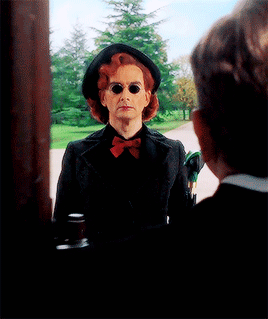
Let me introduce you to Stephanie.
Stephanie, like Crowley, worked for British counterintelligence under the guise of being a Nazi. She disguised herself as a blond, blue eyed, cisgender male SS soldier. This wasn't too difficult, as she did have blonde hair, blue eyes, and was assigned male at birth. No one suspects the scrawny kid in the corner, which is how she appeared while pretending to be a man.
When she was not playing at being Finn, the SS soldier, the Nazi lackey, Stephanie had the advantage of passing as a cisgender female. That way, she could be herself, and not be recognized.
She had been a spy for a number of years then, since before the second war began. She and Crowley met often, exchanging information. Sometimes Crowley came as Astoreth, sometimes as Anthony. Stephanie always came as Stephanie. They respected and understood each other, and that's what made them such good partners in, well, not crime.
(Not that Crowley would ever admit it, however. Perhaps to Stephanie, but to his coworkers Down Below, he didn't work for anyone on earth, and certainly not against Nazis, even if most demons quietly disagreed with the Führer's work. In Falling they were blatantly separated, after all.)
Crowley and Stephanie often met in the private clubs of Soho, but other times, like the second of October, 1941, they met in St. James Park to feed the ducks.
Stephanie tugged on a blonde curl absently, making sure her wig didn't need to be adjusted. (Of course, it didn't, as one always styles a wig before putting it on; however, it was still a habit of hers.) She looked around the decently empty garden, and the couple of flowers that were lively. Tourism wasn't exactly booming since the blitz had started; and the few people in the park could be assumed to be spies, with an occasional local passing through.
One such spy - who was also a local - approached Stephanie at the bench, a loaf of bread, folder, and small paper bag in hand.
"Hello, Astoreth," Stephanie smiled, gesturing to the spot next to her.
"Stephanie," Crowley said, sitting down next to her frien- ahem -fellow agent. She opened up the loaf, already starting to throw crumbs carelessly to the waterfowl. "How's the hair treating you?" she asked politely, referring to the wig she had given Stephanie.
The woman smirked, a sparkle in her eye. "Well, actually. Although I could say yours is growing a little out of style."
Astoreth's eyebrows shot up, her dark red lips in a slight scowl. "Don't tessst me," she hissed.
Stephanie smirked, opening up her own paper bag and pulling out a marmalade sandwich. She took a nibble, watching Astoreth out of the wrinkled corner of an eye.
The older woman made a tsk sound, trying to hide her amusement at the familiar banter. Taking out her own parcel, she brought out a slice of toast and began to spread jam on it.
For a few minutes the two ate, listening to the birds and breathing in the semi-fresh air.
When they were done, Astoreth handed Stephanie her folder. "Let's talk business."
She opened the folder, seeing a detailed sketch inside. It was of a sword, flames sparking out around it. "You've seen it before?" Based on the look in Astoreth's eyes, Stephanie had elected to say it as more of a statement than a question.
"A long time ago," she responded, twisting the snake wrap ring on her finger. It was silver, with small stones on the head and end of the tail.
"What aren't you telling me?"
She hesitated before speaking morosely. "This time... it's personal."
Stephanie raised an eyebrow. "Does this have to do with your boyfriend Azi?"
"He's not my boyfriend!" she said defensively.
"Right, and I'm a man," she chuckled darkly, starting to fiddle with the paperclip that was in the folder.
(To an outsider this statement may not make sense, but Astoreth knew very well that she was referencing the common experience all people had throughout the war: of having to lie about who you really are, and what you really feel.)
A pair of swans swam by, one black and one white, close but not quite touching.
"Either way, when am I going to meet him?" Stephanie asked, expression mischievous. "His bookstore isn't too far from here, right? Less than a mile to Soho."
"No!!! No, that would be chaos!"
"How come? Think he wouldn't like me?"
"The opposite! You guys would hit it off!" Astoreth's hands moved erratically through the air as she spoke. "Then you'd share stories about me, and if I'm being honest he probably wouldn't let you go back to work."
Stephanie smiled. "He sounds like an angel."
Astoreth scoffed, unintelligible noises leaving her again. "No, he's, he's an absolute bastard, nothing like an angel, why would I ever call him an angel?"
The younger woman knew her too well. "You do call him an angel, then? That's a cute pet name."
There was silence, and more throwing of bread.
"Can we please just get back to the sword?" Astoreth asked, sadness hidden behind sunglasses.
Another beat of quiet, the ducks pecking each other a little over the crumbs.
The young Nazi spy fidgeted with the office supply in her hands some more, before answering in a hushed tone. "I haven't seen it. But I've heard the rumors. I didn't want to believe them, but they're coming up with all new kinds of torture technology, I wouldn't be surprised."
(She didn't know it wasn't new. She also didn't know it was as old as the earth itself.)
"Apparently von Reichenau is the one who has it," she finished.
Astoreth grimaced. "von Reichenau? Wasn't he in charge of operation Barbarossa?"
Stephanie nodded. "Yes. He was also the one who ordered the Ukrainian Auxiliaries into Baba Yar."
(Field Marshal Walter von Reichenau of the German Sixth Army did more than plan just those events. He was responsible for many other atrocities and invasions.)
The ginger clenched her sharp jaw. "I have to find him, then."
Suddenly, one of the ducks Crowley was feeding came up to her and snatched the rest of the loaf from her.
Stephanie laughed sourly. "I guess they're as desperate as we are."
Astoreth sighed, looking over to the younger woman. "You need to be careful. I still can't believe they put someone so young into this."
"I'm 26, Ash. I can handle it. Besides, a lot of the real soldiers are far younger than I am.” Her brows furrowed. “We need all the help we can get."
There was a long moment of somber silence between the two women before the blonde stood up. "I should go."
Astoreth didn't respond, but as her fellow spy began to turn, she spoke softly. "A.Z. Fell and Co. Eight o'clock. There will be a Bentley out front. Make sure you're not followed," she practically spat the last part for emphasis.
Stephanie smiled slightly, nodding in affirmation. She reached out to hand Astoreth the paperclip she had been fidgeting with, then promptly left.
Crowley opened her palm to look at the paperclip, turning it around in her hands and letting out a sigh. It had been bent into the outline of a small sword. She closed her fists, looking back out across the river. This wasn't going to be fun.
#let me know tonight and evermore#my writing#Sundry writes#chapter 2#original post#original character#Stephanie#macgyver#reference#Astoreth#fem Crowley#st james park#WWII#WW2#the blitz#nazis#history#swans#ducks#ineffable husbands#ineffable spouses#otp: ineffable#undercover#walter von reichenau#bentley#bookshop#a.z. fell#symbolism#fanfiction#fanfic
19 notes
·
View notes
Text
Männerfarm
Synopses:
The year is 1946, and now, humans enter the animal farm and dominate it, they don’t know what will happen. What if Mr. Frederick had dominated the Animal Farm and its surroundings? The animals now are forced to work and those who are the most against the regime, suddenly disappear. What will happen to Napoleon and Squealer? What is going to change in the farm? What will Benjamin think about this? That is what you are going to see in the fanfic Männerfarm.
Francisco Bertoncini and Fernando
fanfic:
Männerfarm
The animals, now terrified, saw the destruction of their reconstructed windmill. In shock, they could only throw themselves into the humans coming, there was nothing else to do.
During the bloody battle of the Windmill, Napoleon and Squealer were just watching their brave animals, fighting for Napoleon’s farm which could not be placed under Mr. Frederick’s hands, otherwise, they would be completely massacred by the men and their guns.
It is all lost, many of them died, Boxer, unfortunately, was shot in his guts by a man, and again, all were paralyzed watching the situation. Clover ran into him, crying for help, but instead of help, one of Mr. Frederick’s men comes next to him, and then, a bullet comes through his skull, being killed instantly.
Now, Napoleon turns into Mr. Frederick tried to enter into an accord between the two sides, however, nothing went forward, and now, Animal Farm is under men’s hands once again, turning his name to Männerfarm.
The next day, Napoleon and Squealer suddenly disappeared. Benjamin tried to look for both, but they are nowhere to be seen. Animals, again, enter in panic, seeing that there was no one that would protect them from the men, and now, a new men place orders in the house, Mr. Reichenau, which ends with the seven commandments, creating new rules within his power:
All animals and men must follow in Mennismus
All animals must be pure
All animals must give men 70% of their crop as reparations
All animals All animals must salute for Mr. Frederick’s glory
From then on all the remaining animals on the farm had to work for the humans, without the food necessary for them, their life began struggling, and whoever disobeyed men or tried to run away from the farm, was killed in front of the destroyed windmill, to show the other animals how to obey men.
Even though the government changed, the animal’s lives changed little to nothing, old Benjamin started noticing it, which between Napoleon’s era and now, Mr. The Reichenau government, little to nothing changed, being the rations about the same, the amount of work of the animals, still was about the same, so Benjamin noticed that their poor animal lives would never change, rather it would be an Animal Farm, or a Men's Farm.
News now runs through the animal's hands, Napoleon and his comrade Squealer fled the farm during the battle of the windmill! Animals are outraged with the situation, they cannot believe that Napoleon ran out the farm at its most important time, Benjamin realizes that most of the animals were being manipulated by Napoleon and his comrades, something that no one could realize during Napoleon’s regime. The news seems to work, many of the animals seem to believe in the new “Mannismus” ideas.
Now animals just follow Mr. Reichenau's ideas, working really hard, but really tired for the reconstruction of the Windmill and feared something would happen to them. They now see Napoleon as a tyrant, a coward that didn’t protect their farm in the most important time, running away from problems. Many of the animals now reject their old Animalism to be placed in the new society, avoiding something worse.
Glossary:- Männerfarm = Man’s Farm (in German) (represents an German protectorate/Russia being dominated by Germans)
- Mannismus = Mennalism (in German) (Animalism, but for Men, representing in the real world Nazism)
- Mr. Reichenau = An ideal of a German Field Marshal who invaded the Soviet Union (Walter Von Reichenau), and now, commanding Russia.
0 notes
Photo
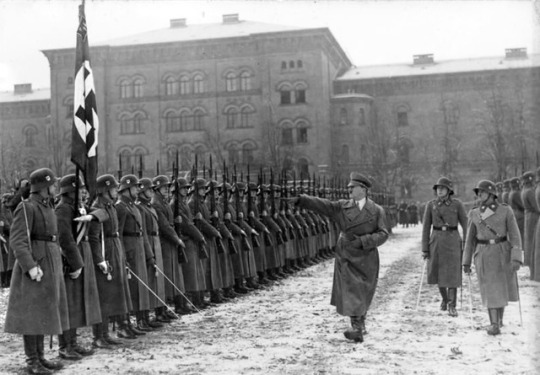
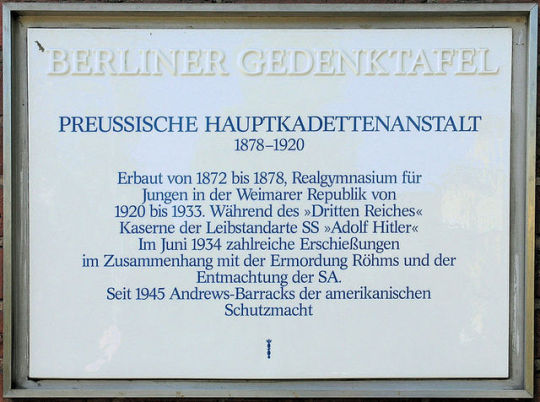
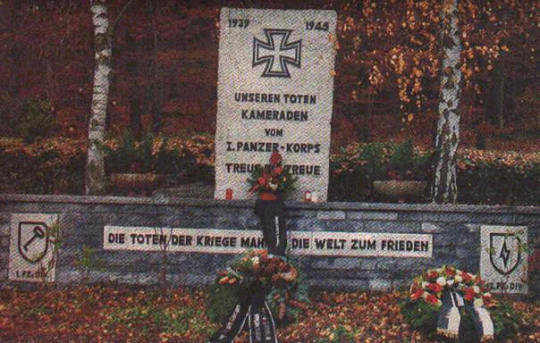
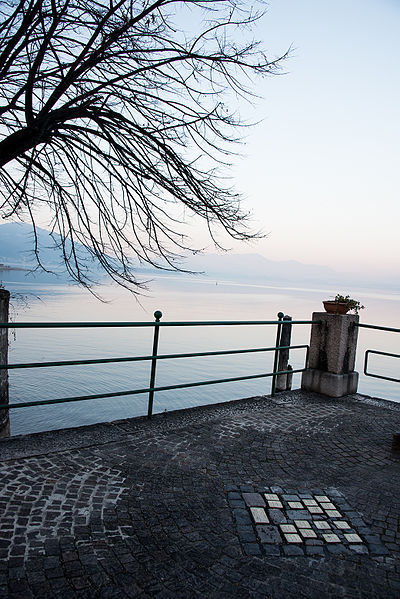
Leibstandarte SS Adolf Hitler (LSSAH), Kaserne Lichterfelde, 17. Dezember 1935
Bundesarchiv Deutschen Reich (Kaiserreich, Weimarer Republik, NS-Diktatur und DDR)
Der Kasernenneubau der Leibstandarte SS Adolf Hitler ist im Zweiten Weltkrieg gering beschädigt worden.
1934 ermordete die LSSAH auf Befehl Hitlers beim sogenannten „Röhm-Putsch“ Teile der SA-Führung, die selbst eine paramilitärische Organisation der NSDAP war. Zusammen mit den Politischen Bereitschaften bildete die Leibstandarte die SS-Verfügungstruppe, aus der 1940 die Waffen-SS hervorging.
Bereich eigenen Rechts und persönlicher Souveränität
Die Leibstandarte wurde aus rund 120 Mann, die teils schon im Münchner Braunen Haus eine ähnliche Funktion hatten, unter Sepp Dietrich aufgestellt. Solange Hitler nur Parteiführer war, war der persönliche Eid seiner vormaligen Stabswache nach dem Urteil Hans Buchheims „ein romantischer, jedenfalls aber ein bedeutungsloser Akt“. Nachdem er jedoch 1933 Reichskanzler und 1934 nach dem Tod Paul von Hindenburgs auch Staatsoberhaupt wurde, „gewann ein ihm persönlich geleisteter Eid einzigartige verfassungsrechtliche Bedeutung. Denn der Kanzler beziehungsweise das Staatsoberhaupt schuf sich auf diese Weise nicht kraft seines Amtes, sondern als Person einen Bereich eigenen Rechts und persönlicher Souveränität neben der Partei und allen Einrichtungen des Staates.“
Der erste Einsatz der Leibstandarte jenseits der Repräsentationsaufgaben erfolgte Ende Juni / Anfang Juli 1934, als sie nach der von Reinhard Heydrich erstellten „Säuberungsliste“ beim angeblichen „Röhm-Putsch“ mithalf, große Teile der SA-Führung und andere Personen zu ermorden. Die Transportmittel hierzu hatte Sepp Dietrich am 27. Juni bei Walter von Reichenau vom Reichswehrministerium für einen „geheimen und sehr wichtigen Auftrag des Führers“ erbeten. Die Reichswehr war im Vorfeld von der NSDAP-Führung informiert worden.
Dietrich selbst begab sich nach München und erhielt dort von Hitler persönlich den Auftrag, das Exekutionskommando für die in Stadelheim „inhaftierten“ SA Führer Hans Hayn, Edmund Heines, Peter von Heydebreck, Wilhelm Schmid, August Schneidhuber und Hans Erwin von Spreti-Weilbach zusammenzustellen. Dietrich wurde 1957 wegen Beihilfe zum Totschlag hierfür zu einer Haftstrafe verurteilt.
Auf dem Gelände der Kaserne der Leibstandarte in Berlin-Lichterfelde (ehemalige Hauptkadettenanstalt) wurden weitere verhaftete SA-Führer von der Leibstandarte ermordet: Veit Ulrich von Beulwitz, Georg von Detten, Karl Ernst, Hans-Joachim von Falkenhausen, Daniel Gerth, Willi Klemm, Hans-Karl Koch, Fritz von Kraußer, Walter von Mohrenschildt, Wilhelm Sander, Konrad Schragmüller, Erwin Villain und Gerd Voss. Hinzu kamen die drei in Ungnade gefallenen SS-Angehörigen Joachim Hoffmann, Gustav Fink und Fritz Pleines. Der Ministerialdirektor im Reichsverkehrsministerium und Vertreter des politischen Katholizismus Erich Klausener wurde von Kurt Gildisch, der zuvor zur Leibstandarte abkommandiert wurde, in seinem Dienstzimmer ermordet. Gildisch wurde hierfür am 18. Mai 1953 zu einer Zuchthausstrafe von fünfzehn Jahren verurteilt.
Die kaltblütige Ausübung der Tötungsaktionen zahlte sich für die SS-Einheit schon kurze Zeit nach der Tat aus. Bereits am Abend des 30. Juni soll Hitler Dietrich versprochen haben, die Leibstandarte als Anerkennung für ihre Dienste mit modernen Waffen auszurüsten. Tatsächlich bestätigte Reichswehrminister Werner von Blomberg nur fünf Tage später, am 5. Juli 1933, den Befehlshabern der Wehrmacht, dass die Reichswehr Mittel zur Bewaffnung einer SS-Division bereitstellen werde.
Im Juli 1945 übernahmen die US Army die Kasernenanlage. Die Berliner US-Streitkräfte gaben ihr den Namen Andrews Barracks. Im Jahr 1953 bauten die Amerikaner eine Kirche auf dem Gelände; dabei wurden die noch erhaltenen Teile des aus dem 19. Jahrhundert stammenden historischen Kadettendoms abgerissen. Es folgten weitere Neubauten, wobei man sich allerdings nicht an die alten Ansichten und Grundrisse hielt. Von der ursprünglich ausgedehnten Gesamtanlage sind der südöstliche Kasernentrakt, einzelne Wohnhäuser und das Kommandantenhaus im Westen erhalten.
Seit dem Abzug der Alliierten 1994 wird das Gelände der Hauptkadettenanstalt vom Bundesarchiv genutzt; dort sind heute die zentralen Archive des Deutschen Reichs (Kaiserreich, Weimarer Republik, NS-Diktatur) und der DDR zusammengefasst.
Ab Sommer 2006 ist ein Magazinneubau auf dem Gelände geplant, in dem weitere Teile des Bundesarchivs zusammengeführt werden sollen.
Die LSSAH trägt die Verantwortung für zahlreiche Kriegsverbrechen an der Ost- und Westfront. Damit fing die Einheit schon wenige Wochen nach dem Überfall auf Polen an. Neben anderen Vorkommnissen gingen in der Nacht vom 18./19. September 1939 westlich von Warschau Hauptsturmführer Hermann Müller-John mit seinen Männern auf „Judenjagd“. Dabei wurden 50 jüdische Zivilgefangene erschossen. Die Mordaktion war nach Angaben des Historikers Westemeier so grausam, dass Müller-John daraufhin von einer Wehrmachteinheit verhaftet und vor ein Kriegsgericht gestellt werden sollte. Der Gefangene sandte an den Kommandeur Sepp Dietrich ein Telegramm, in dem er einerseits seine Aussagen vor den Untersuchungsbehörden mit ihm absprach und andrerseits um Hilfe bat. Dietrich bestand auf der Freilassung Müller-Johns. Dieser wurde schließlich auf Befehl Hitlers freigelassen.
Weitere bekannte Mordtaten sind die Erschießung von etwa 80 bis 100 britischen Kriegsgefangenen 1940 in Wormhout, die Ermordung von 34 französischen Zivilisten in Tavaux und Plomion(woran auch Soldaten der 12. SS-Panzer-Division „Hitlerjugend“ beteiligt waren), sowie das Malmedy-Massaker (17. Dezember 1944), bei dem 72 amerikanische Soldaten erschossen wurden, obwohl sie sich bereits ergeben hatten. Ebenfalls ermordeten Soldaten der Division beim Wereth-Massaker im Dezember 1944 11 afroamerikanische US-Soldaten. An der Ostfront tötete die Division bei der Rückeroberung Charkows eine große Anzahl Verwundeter und Gefangener.
Angehörige der Leibstandarte verübten u. a. die ersten Massenmorde an Juden in Italien, die Massaker vom Lago Maggiore: Zwischen dem 15. und 23. September 1943 ermordeten sie 54 Juden auf der piemontesischen Seite des Lago Maggiore. Zudem ermordeten sie im Oktober 1943 den italienischen Juden Ettore Ovazza und seine ganze Familie in Intra. Die Division war nach Chivasso verlegt worden, wobei ein Bataillon am Westufer des Lago Maggiore lag. Ein weiteres Bataillon, im Polizeihaftlager Borgo San Dalmazzo stationiert, lauerte einer größeren Gruppe von Juden auf, die auf der Flucht aus Frankreich war. Die SS-Männer fingen 349 von ihnen ein. Sie wurden in einer Kaserne der Alpini eingesperrt, die als Zwischenlager für Juden diente, und am 21. November über Frankreich nach Auschwitz verfrachtet. Nur neun von ihnen überlebten. Eine andere SS-Einheit unter dem Bataillonskommandeur Joachim Peiper ermordete bei einem Massaker in Boves bei Cuneo 24 überwiegend alte und kranke Menschen. Danach hatten die SS-Leute in einem Haus den Ortspfarrer Don Bernardi und den Unternehmer Vassallo eingeschlossen, die als Parlamentäre erfolgreich die Freilassung von zwei gefangen genommenen deutschen Soldaten zwischen den SS-Männern und Angehörigen von Partisanengruppen ausgehandelt hatten. Die SS steckte dann neben 300 Häusern, die völlig zerstört wurden, auch dieses in Brand, so dass beide darin verbrannten.
Stolpersteine zur Erinnerung an das Massaker von Meina
Die Massaker vom Lago Maggiore waren die ersten Massenmorde an Juden in Italien. Im September 1943 ermordeten Angehörige der 1. SS-Panzer-Division Leibstandarte SS Adolf Hitler 50 Juden auf der piemontesischen Seite des Lago Maggiore, darunter 16 Gäste des Hotels Meina, das Massaker von Meina. Dazu kamen weitere Morde an Juden in räumlichem und zeitlichem Zusammenhang, nämlich im September in Novara sowie im Oktober in Intra, so dass oft eine Opferzahl von insgesamt 56 Personen angegeben wird. 1968 verurteilte das Landgericht Osnabrück insgesamt fünf Personen wegen dieses Verbrechens, der Bundesgerichtshof hob jedoch 1970 die Urteile wegen Verjährung auf.
Kommandeure der SS
15. August 1938 bis 4. Juli 1943 Josef Dietrich
4. Juli 1943 bis 20. August 1944 Theodor Wisch
20. August 1944 bis 6. Februar 1945 Wilhelm Mohnke
6. Februar 1945 bis 8. Mai 1945 Otto Kumm
Bekannte Angehörige der SS
Otto Beisheim, SS-Kanonier und Metro-Konzern-Gründer
Kurt Borm, Euthanasie-Täter
Herbert Döhring, Hausverwalter von Hitlers Berghof
Kurt Gildisch, SS-Führer (Haftstrafe für einen Mord, den er im Auftrag und als Angehöriger der Leibstandarte begangen hat)
Otto Günsche, SS-Führer und letzter persönlicher Adjutant Hitlers
Ernst Klink, Autor
Hugo Kraas, SS-Führer
Felix Lützkendorf, Dramaturg, Drehbuchschreiber und Filmregisseur
Theo M. Loch, SS-Obersturmführer – Journalist
Rochus Misch, Leibwächter Hitlers – in Dokumentationen wird er als „Funker Hitlers“ bezeichnet.
Johann Niemann, zuletzt Kommandant des Vernichtungslagers Sobibor; Tod bei einem Häftlingsaufstand
Joachim Peiper, SS-Führer (verurteilt wegen Kriegsverbrechen der Leibstandarte)
Otto Reich, SS-Führer
Hans-Albin Freiherr von Reitzenstein, SS-Führer
Franz Schönhuber, Politiker der Republikaner und DVU
Heinrich Schütz, KZ-Arzt
Herbert Schweiger, Buchautor
Bernhard Siebken, SS-Führer
Karl-Heinz Spilker, SS-Obersturmführer, ehemaliges Mitglied des Bundestages (für die CSU)
Wolfgang Venohr, Journalist und Sachbuchautor
Herbert Walther, SS-Untersturmführer der Waffen-SS, Sachbuchautor
Michael Wittmann, SS-Hauptsturmführer der Waffen-SS
Denkmal für die Waffen-SS (Marienfels)
1971 wurde in Marienfels (Taunus) ein Denkmal als Mahnmal für die Gefallenen der „1. SS-Panzer-Division Leibstandarte SS Adolf Hitler“ und der 12. SS-Panzer-Division „Hitlerjugend“ errichtet. Von 2003 an war es Zielort mehrerer rechtsextremer Kundgebungen und Aufmärsche. 2004 wurde das Denkmal von Unbekannten zerstört und anschließend eingelagert. Anfang 2006 geriet es erneut in die Schlagzeilen, als es auf dem Privatgrundstück des Neonazis Thorsten Heise in Fretterode wiederaufgebaut wurde.
Am 8. Mai 2004 sammelten sich erneut etwa 200 Rechtsextreme, um über den Verlust des Denkmals zu klagen und den Wiederaufbau des Gedenksteins zu fordern. Neben den regionalen Kameradschaften Westerwald, MSC 28 (Limburg) und der Schwarzen Division Rheinhessen kamen zahlreiche Neonazis aus dem benachbarten Nordrhein-Westfalen, die mit Claus Cremer, Ralph Tegethoff und dem Bonner NPD-Kreisvorsitzenden Robert Klug auch die Redner stellten. Die Mobilisierung wurde durch das Aktionsbüro Norddeutschland unter Christian Worch vorangetrieben.
Zum dritten Mal innerhalb eines Jahres demonstrierten etwa 300 Menschen für den Wiederaufbau am 20. November 2004 im nahegelegenen Nastätten im Taunus. Diese waren überwiegend einheimische Bürger aus der Umgebung.
3 notes
·
View notes
Photo

#Alto #escalão #nazista: Adolf #Hitler, Walter von #Reichenau, Erwin #Rommel e Martin #Bormann #observando o #cerco de #Varsóvia. . #AdolfHitler, #WalterReichenau, #ErwinRommel #MartinBormann #SegundaGuerra #WW2 #WW2 #CercoDeVarsóvia #Nazismo #Nazista #Alemanha #Judeus . . ... https://www.instagram.com/p/CCsmsdZHCn1/?igshid=e4sfjt44sarg
#alto#escalão#nazista#hitler#reichenau#rommel#bormann#observando#cerco#varsóvia#adolfhitler#walterreichenau#erwinrommel#martinbormann#segundaguerra#ww2#cercodevarsóvia#nazismo#alemanha#judeus
0 notes
Text

HE FUCKING POURED WATER INTO REICHENAU'S WINE IN FRONT OF DER FÜHRER AHAHAHA I'M AT LOSS FOR WORDS oh fedi you sly little man
#I CAN'T#I REALLY CAN'T#but I love him sm#fedor von bock#fedi#walter von reichenau#generalfeldmarschall#later#herr#3rd reich#wwii books#ww2 books#fedor von bock: the war diary#tw: cursing#literasi ro#book#reading
7 notes
·
View notes
Text

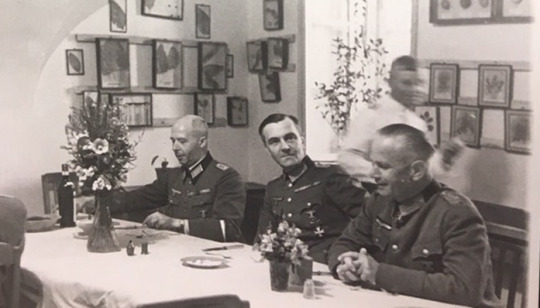
Paulus and von Reichenau with cats is nice enough :)
21 notes
·
View notes
Text
El bosque que esconde el horror: las fosas de los 800 niños de Tarnow asesinados por los nazis
El bosque que esconde el horror: las fosas de los 800 niños de Tarnow asesinados por los nazis
Los niños del “orfanato”: ninguno tenía más de 8 años (Foto: Archivo Walter Von Reichenau) Por Matías Bauso Alrededor de 10 mil personas de la pequeña ciudad de Polonia fueron masacradas: unos 6000 judíos y unos 2000 polacos católicos en junio de 1942. La atroz historia y la conmovedora experiencia de los documentalistas de Marcha por la Vida en el bosque donde se impone el espanto Leer nota…
View On WordPress
0 notes
Text

The first of the Babi Yar massacres was particularly sickening because the victims were given some hope before they were butchered.I decided not to put any pictures that are too disturbing in this blog. The story is disturbing enough
Axis forces, mainly German, occupied Kiev on 19 September 1941. Between 20 and 28 September, explosives planted by the Soviet NKVD caused extensive damage in the city; on 24 September an explosion rocked Rear Headquarters Army Group South.Two days later, on 26 September, Maj. Gen. Kurt Eberhard, the military governor, and SS-Obergruppenführer Friedrich Jeckeln, the SS and Police Leader met at Rear Headquarters Army Group South.
There, they made the decision to exterminate the Jews of Kiev, claiming that it was in retaliation for the explosions.Also present were SS-Standartenführer Paul Blobel, commander of Sonderkommando 4c, and his superior, SS-Brigadeführer Dr. Otto Rasch, commander of Einsatzgruppe C. The mass killing would be carried out by units under the command of Rasch and Blobel, who were ultimately responsible for a number of atrocities in Ukraine in the summer and autumn of 1941.
P/J 11
The implementation of the order was entrusted to Sonderkommando 4a, commanded by Blobel, under the general command of Friedrich Jeckeln.This unit consisted of SD and Sipo, the third company of the Special Duties Waffen-SS battalion, and a platoon of the 9th Police Battalion. Police Battalion 45, commanded by Major Besser, conducted the massacre, supported by members of a Waffen-SS battalion. Contrary to the myth of the “clean Wehrmacht”, the Sixth Army under Walter von Reichenau worked together with the SS and SD to plan the mass murder of the Jews of Kiev.
An order was posted:

“All Jews of the city of Kiev and its vicinity must appear on Monday, September 29, by 8 o’clock in the morning at the corner of Mel’nikova and Dorohozhytska streets (near the Viis’kove cemetery). Bring documents, money and valuables, and also warm clothing, linen, etc. Any Jews who do not follow this order and are found elsewhere will be shot. Any civilians who enter the dwellings left by Jews and appropriate the things in them will be shot.”
On 29 and 30 September 1941, a special team of German SS troops supported by other German units and local collaborators murdered 33,771 Jewish civilians after taking them to the ravine.
The commander of the Einsatzkommando reported two days later:
The difficulties resulting from such a large scale action—in particular concerning the seizure—were overcome in Kiev by requesting the Jewish population through wall posters to move. Although only a participation of approximately 5,000 to 6,000 Jews had been expected at first, more than 30,000 Jews arrived who, until the very moment of their execution, still believed in their resettlement, thanks to an extremely clever organization.
According to the testimony of a truck driver named Hofer, victims were ordered to undress and were beaten if they resisted.
The crowd was large enough that most of the victims could not have known what was happening until it was too late; by the time they heard the machine gun fire, there was no chance to escape. All were driven down a corridor of soldiers, in groups of ten, and then shot.
In the evening, the Germans undermined the wall of the ravine and buried the people under the thick layers of earth.According to the Einsatzgruppe’s Operational Situation Report, 33,771 Jews from Kiev and its suburbs were systematically shot dead by machine-gun fire at Babi Yar on 29 September and 30 September 1941.
The money, valuables, underwear and clothing of the murdered victims were turned over to the local ethnic Germans and to the Nazi administration of the city.Wounded victims were buried alive in the ravine along with the rest of the bodies.

Dina Pronicheva, an actress of the Kiev Puppet Theatre, and a survivor.Gave testimony during on 24 January 1946, at a Kiev war-crimes trial of fifteen members of the German police responsible for the occupied Kiev region.

She was one of those ordered to march to the ravine, to be forced to undress and then be shot. Jumping before being shot and falling on other bodies, she played dead in a pile of corpses.
She held perfectly still while the Nazis continued to shoot the wounded or gasping victims. Although the SS had covered the mass grave with earth, she eventually managed to climb through the soil and escape. Since it was dark, she had to avoid the torches of the Nazis finishing off the remaining victims still alive, wounded and gasping in the grave. She was one of the very few survivors of the massacre and later related her horrifying story to Kuznetsov. At least 29 survivors are known.
Babi Yar- Like lambs led to the slaughter. The first of the Babi Yar massacres was particularly sickening because the victims were given some hope before they were butchered.I decided not to put any pictures that are too disturbing in this blog.
0 notes
Text
funny how according to Richard Brett-Smith's book 'Hitler's Generals', Hitler described Reichenau as one of "my two most brutal-looking generals" while Fedor in his diary (entry of 29/05/40) wrote of Reichenau: "he is and remains a "big kid"."
#surely my fedi has no fear of everyone#he is THE FEAR.#but I agree with him tho#Reichenau is basically just a big kid living in his own world with his own vibe#he got that middle child energy going strong inside him#fedor von bock#fedi#walter von reichenau#adolf hitler#generalfeldmarschall#heer#3rd reich#third reich#Hitler's Generals#Richard Brett-Smith#fedor von bock: the war diary#ww2 books
5 notes
·
View notes